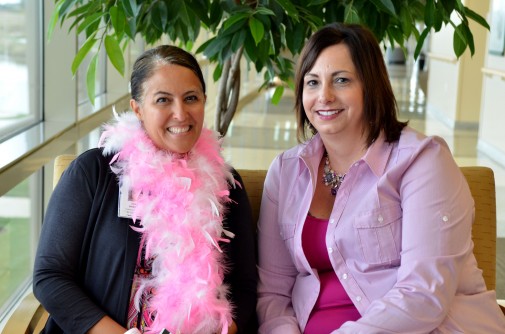Related Posts
Comments
About the Author
health enews staff is a group of experienced writers from our Advocate Health Care and Aurora Health Care sites, which also includes freelance or intern writers.

Tina Link and Kari Weisenberger turned 40 within a month of each other, so they decided to do something special together – get their first mammograms.
Although mammograms play a key role in detecting breast cancer early, when treatments are more likely to be successful, many women dread mammograms due to tales of the pain involved with getting their breasts pressed together. Others fear the unknown and a possible breast cancer diagnosis.
“I was a little anxious, a little nervous,” says Link, manager of community health at Advocate Sherman Hospital in Elgin, Ill. “I wanted to know what it was going to feel like, what to expect. You hear everyone talking about what it feels like – the squishing. It wasn’t bad, and doing it together helped.”
The American Cancer Society recommends screening mammograms for women starting at 40 years old. For those under 40, discussing family health with a doctor can help determine when to schedule a first mammogram.
Patients can receive the traditional mammogram, which is a flattened image or 2D, or 3D mammogram, a newer form of mammography that takes images of the breasts in layers. Also known as tomosynthesis, 3D mammograms have shown to reduce the number of false positive results and detect more invasive forms of breast cancer.
Due to their age, risk factors and family history, Link and Weisenberger each had 3D mammograms at the Center for Breast Care at Sherman Hospital.
“Honestly, it was a piece of cake,” says Weisenberger, who is a radiation therapy coordinator at Sherman Hospital. “I didn’t have a picture in my mind of what it would be like, but it exceeded my expectations.”
Link agrees.
“It wasn’t that bad,” she says. “It just cranks down, squishes and you are done. You have to hold your breath for a few seconds and then you are told to breathe – two photos on each side and you are done. That’s it. It’s nothing to be worried about.”
There are three possible results from a screening mammogram: negative, if it is completely normal; benign, if there are some findings, but they are clearly benign; and incomplete, if further evaluation is needed.
“Even when the news is bad, there is tremendous hope because treatment is now so effective,” says Dr. Stephen Grossman, a radiology and breast specialist at the Center for Breast Care. “When caught at an early stage, breast cancer is very treatable with a high success rate.”
“Doing it together helped,” says Weisenberger. “You have someone to talk to about your experience in real-time. You hold each other accountable, and have a partner to help you from that point on.”
To learn more about breast health, visit Stories of the Girls.

health enews staff is a group of experienced writers from our Advocate Health Care and Aurora Health Care sites, which also includes freelance or intern writers.
Get these health and wellness insights emailed to you three times a week.

With our LiveWell app and website, you can manage health and wellness for yourself and for everyone who counts on you.
Download the app
Do you cook from the heart? This is what you need to know.